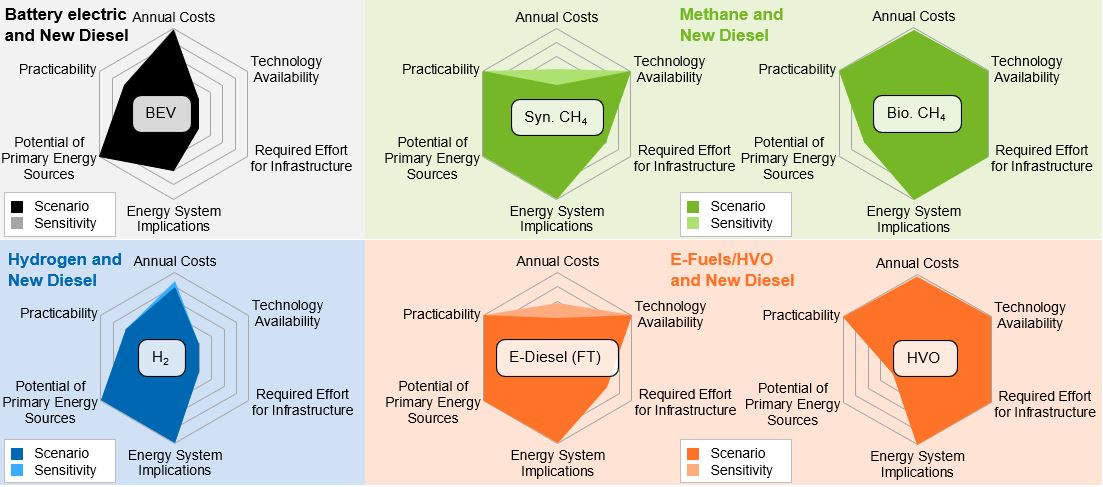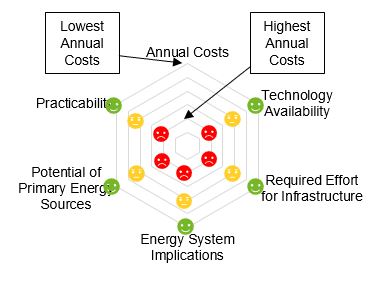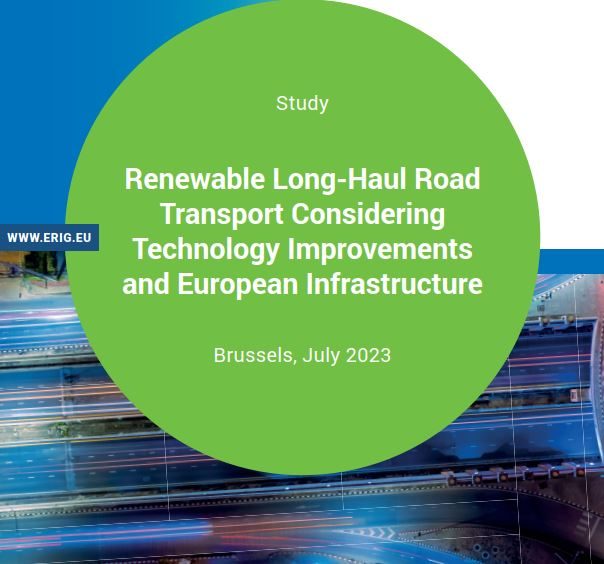New ERIG-study on long haul heavy duty road transport emission reduction potential of different technologies to 2030
Brussels, July, 2023 – Study on Renewable Long-Haul Road Transport Considering Technology Improvements and European Infrastructures (ReHaul) published
Following up on the technical paper on the
“Effects of European CO2-Regulations for Vehicles on the European Energy System”
the team of scientists coordinated by Prof. Dr. Markus Friedl at the Eastern Switzerland University of Applied Sciences (OST) within the ERIG community have conducted a more extensive study specifically looking at the different technological options for the substantial green house gas (GHG) emissions reduction in long haul heavy duty road transport.
By formulation of four theoretical cases, where each renewable technology is combined with diesel trucks in such a ratio that 40% GHG emissions reduction in relation to 2005 are met at 2030 in a Well-to-Wheel evaluation, strengths and weaknesses of each of the investigated options are revealed in so called “Exclusive Scenarios”. The scenarios do not only look at costs of vehicle and charging/refuelling infrastructure but also evaluate other essential criteria, such as Technology Availability, Required Effort for Infrastructure, Energy System Implications, Potential of Primary Energy Sources and Practicability in a qualitative way.
From the background of increasing GHG emissions in long-haul road transport, it is clear that political efforts for renewable technological options are required, not only to interrupt the trend, but to turn it around to get on track with the overall ambitions in the European Green Deal.
Apart from Battery electrical and Hydrogen fuel cell options, there are also renewable fuels suited for conventional internal combustion trucks. Renewable methane from biogas and from power-to-gas can be used both in gaseous as well as cooled down into liquid form. Renewable liquid fuels from Hydrogenated Vegetable Oils (HVO) and from power-to-liquids (E-fuels) are further options. Both these groups of energy carriers have the advantage of either being one to one compatible with existing fleets and refuelling infrastructure or at least already be established in the market.
The study shows that biological and synthetic renewable fuels offer an overall compelling option to decarbonise long haul heavy duty road transport, in short the term as well as with a long term perspective thanks to the primary energy potential of synthetic fuels. The newer technologies of battery electrical and hydrogen fuel cell vehicles are recognized to have strengths in overall efficiency and costs, while commercialization and infrastructure build-up are continued it is estimated that they can have an effect in medium- to long-term. However, current European regulation differs from the scientific approach of evaluating all GHG emissions over the complete lifecycle, or as in the simplification made in this study, from well-to-wheel. Thus, when a regulation only considers Tank-to-Wheel emissions, battery electric and hydrogen has an unfair advantage, since they have no GHG emissions in that portion of the lifecycle and in addition other renewable biological and synthetic options have a disadvantage as their tank-to-wheel emissions are considered equally bad as the conventional fossil fuel. This approach in regulation stands in contrast with the results of the evaluation of the exclusive scenarios in this study. The scientific team conducting the study advises to consider the following parameters in EU regulation:
- Give long-term security for investments into vehicles and infrastructure by defining European and definite rules.
- Set technology-neutral regulations demanding the same strict goals on GHG emissions from all technologies. (“green-washing” must be avoided)
- The GHG emissions reduction goals, should be at least Well-to-Wheel (WtW) approaches, if considering the entire life cycle (LCA) is not practically possible.
This should have the objective to establish a level playing field between the different technology options and dissolve current biased regulatory conditions.
It should lead to investments in efficient conventional internal combustion engines (ICE) are not discouraged and thereby enable faster GHG emission reduction in combination with continued encouragement of investment in renewable (liquid and gaseous) fuel production, transport and refuelling infrastructure. Commercialization of battery electric trucks (BEV) and fuel cell trucks (FCEV) vehicles, components and infrastructure can take place in parallel, leading to a variety of green technologies available, that allows different countries and fleet operators with different requirements and use-cases to find the best fitting pathway to their renewable long-haul heavy-duty road transport.
Qualitative Assessment – Evaluation Results

- Every «Exclusive scenario» represents an operating fleet in 2030 fulfilling the EU’s goals for GHG emissions and which is composed of one renewable technology and new diesel.
- No Life Cycle Analysis: the emissions from the production of the vehicles are excluded from the GHG emissions targets.
- Annual Costs include costs for electricity, fuel production and transport, refuelling and fleet.
- Sensitivity: electricity costs reduced to 50%
Qualitative Assessment – Assumptions and conditions

- Annual Cost: Based on the quantitative analysis.
- Technology Availability: at least TRL 7, availability of commercial products, announcements for future product releases: Production, Transport, Refuelling Stations and Charging Points, Powertrains.
- Required Effort for Infrastructure 2030: Delta between now and 2030: Production, Transport/Storage, Refuelling, Charging.
- Energy System Implications, Efficiency, Storability: Additional effects on the energy system as a whole.
- Potential of Primary Energy Source: Availability boundaries. Not only long-haul heavy duty road transport needs energy. Consider entire energy system.
- Practicability: Issues remaining on a long term, i.e. charging times and safety measures etc.


